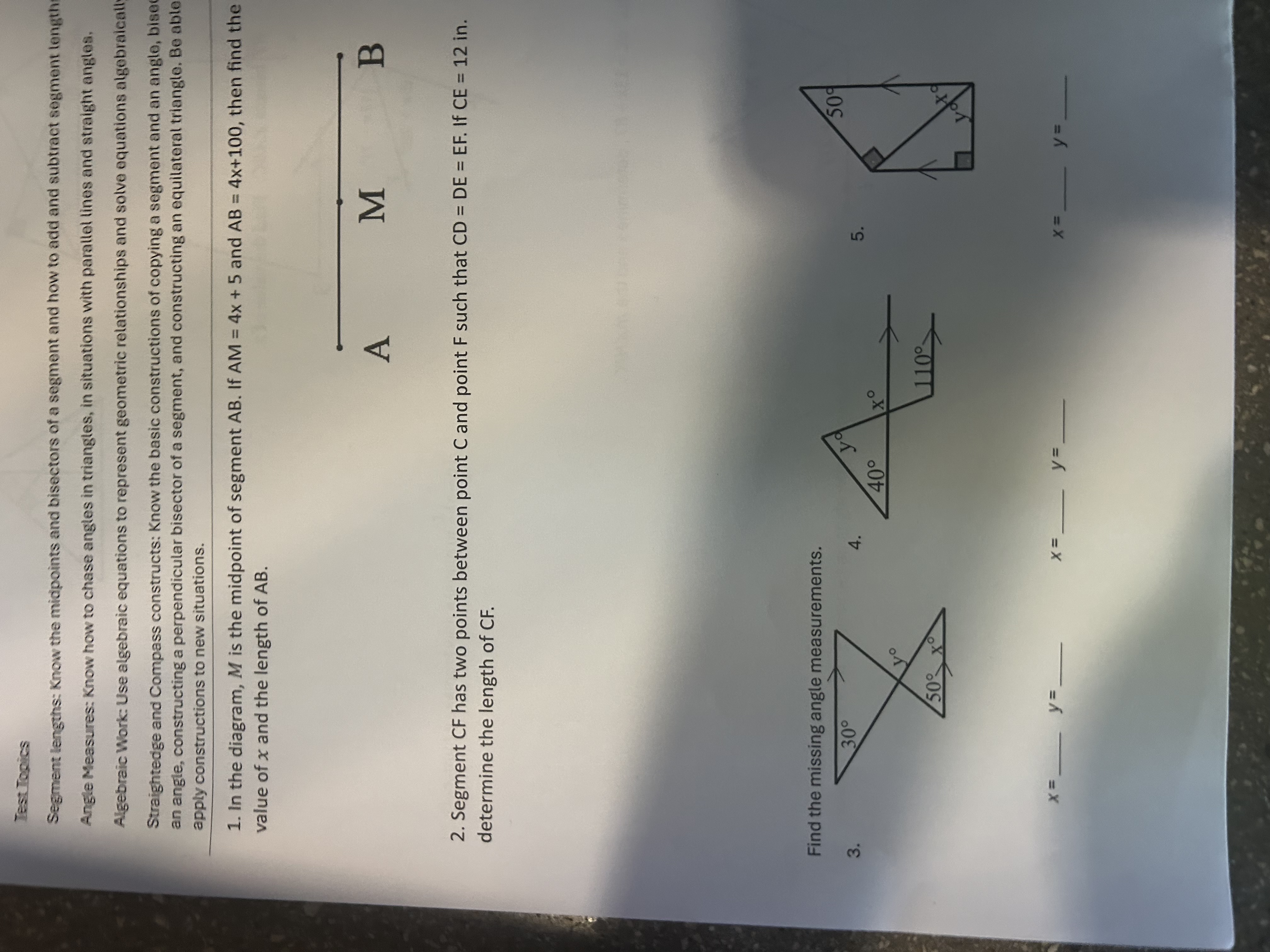1. In the diagram, M is the midpoint of segment AB. If AM = 4x + 5 and AB = 4x + 100, then find the value of x and the length of AB. 2. Segment CF has two points between point C an... 1. In the diagram, M is the midpoint of segment AB. If AM = 4x + 5 and AB = 4x + 100, then find the value of x and the length of AB. 2. Segment CF has two points between point C and point F such that CD = DE = EF. If CE = 12 in, determine the length of CF. Find the missing angle measurements.

Understand the Problem
The question involves solving for lengths and angles in geometric figures involving segments and angles. It includes tasks such as finding missing segment lengths and calculating the measures of unknown angles in given diagrams. The approach will entail applying properties of midpoints, segments, and angle relationships in geometry.
Answer
1. \( x = 22.5 \
Answer for screen readers
-
( x = 22.5 ) and ( AB = 190 )
-
( CF = 18 )
Angles: 3. ( x = 100 ) 4. ( x = 40 ), ( y = 30 ) 5. ( x = 80 ), ( y = 50 )
Steps to Solve
- Setting up the equation for segment lengths
Since M is the midpoint of segment AB, we have:
$$ AM = MB $$
Given that ( AM = 4x + 5 ) and ( AB = 4x + 100 ), it follows that:
$$ AB = AM + MB = 2 \cdot AM $$
Thus, we can rewrite the equation:
$$ 4x + 100 = 2(4x + 5) $$
- Solving for ( x )
Expanding the right side:
$$ 4x + 100 = 8x + 10 $$
Now, we will isolate ( x ) by moving ( 4x ) to the right:
$$ 100 = 4x + 10 $$
Subtract 10 from both sides:
$$ 90 = 4x $$
Now, divide by 4:
$$ x = \frac{90}{4} = 22.5 $$
- Finding the length of segment AB
Substituting ( x = 22.5 ) back into ( AB = 4x + 100 ):
$$ AB = 4(22.5) + 100 $$
Calculating this gives:
$$ AB = 90 + 100 = 190 $$
- Finding the length of CF
From the problem, CD = DE = EF, and CE = 12. If we denote each segment as ( x ), we have:
$$ CE = CD + DE $$
Since ( CD = DE = EF = x ), thus:
$$ CE = x + x = 2x $$
Given that ( CE = 12 ), we solve for ( x ):
$$ 2x = 12 $$
Divide by 2:
$$ x = 6 $$
Since CF has three segments ( CD, DE, EF ):
$$ CF = CD + DE + EF = x + x + x = 3x $$
Substituting ( x = 6 ):
$$ CF = 3(6) = 18 $$
- Finding angle measurements (for parts 3, 4, and 5)
For part 3, since we have two angles ( 30^\circ ) and ( 50^\circ ):
The angles on a straight line sum to:
$$ x + 30 + 50 = 180 $$
Thus,
$$ x + 80 = 180 \implies x = 100 $$
Now, for part 4 with ( y ) and ( x = 40^\circ ):
Using the property of transversals:
$$ 110 + x + 40 + y = 180 $$
Rearranging gives:
$$ x + y + 150 = 180 \implies y = 30 $$
Lastly for part 5, with ( 50^\circ ) and a right angle, we find:
Since ( y + 50 + x = 180 ):
$$ x = 180 - 50 - y \implies x = 130 - y $$
If we know ( y ):
For ( y ) being an exterior angle implies:
$$ y = 50 + x $$
By substituting ( x ):
$$ x = 80, y = 50 $$
In conclusion, based on the calculations:
- From problem 1: ( x = 22.5 ) and ( AB = 190 )
- From problem 2: ( CF = 18 )
For angles:
- ( x = 100 ) for part 3
- ( x = 40 ), ( y = 30 ) for part 4
- ( x = 80 ), ( y = 50 ) for part 5
-
( x = 22.5 ) and ( AB = 190 )
-
( CF = 18 )
Angles: 3. ( x = 100 ) 4. ( x = 40 ), ( y = 30 ) 5. ( x = 80 ), ( y = 50 )
More Information
The value of ( x ) is calculated based on the midpoint of the segment using properties of segments. The angles derived throughout the problem leverage the fact that angles on straight lines sum to ( 180^\circ ).
Tips
- Confusing midpoint properties leading to incorrect segment lengths.
- Misapplying angle relationships, especially in triangles and transversals.
- Not correctly substituting values back into original equations.
AI-generated content may contain errors. Please verify critical information